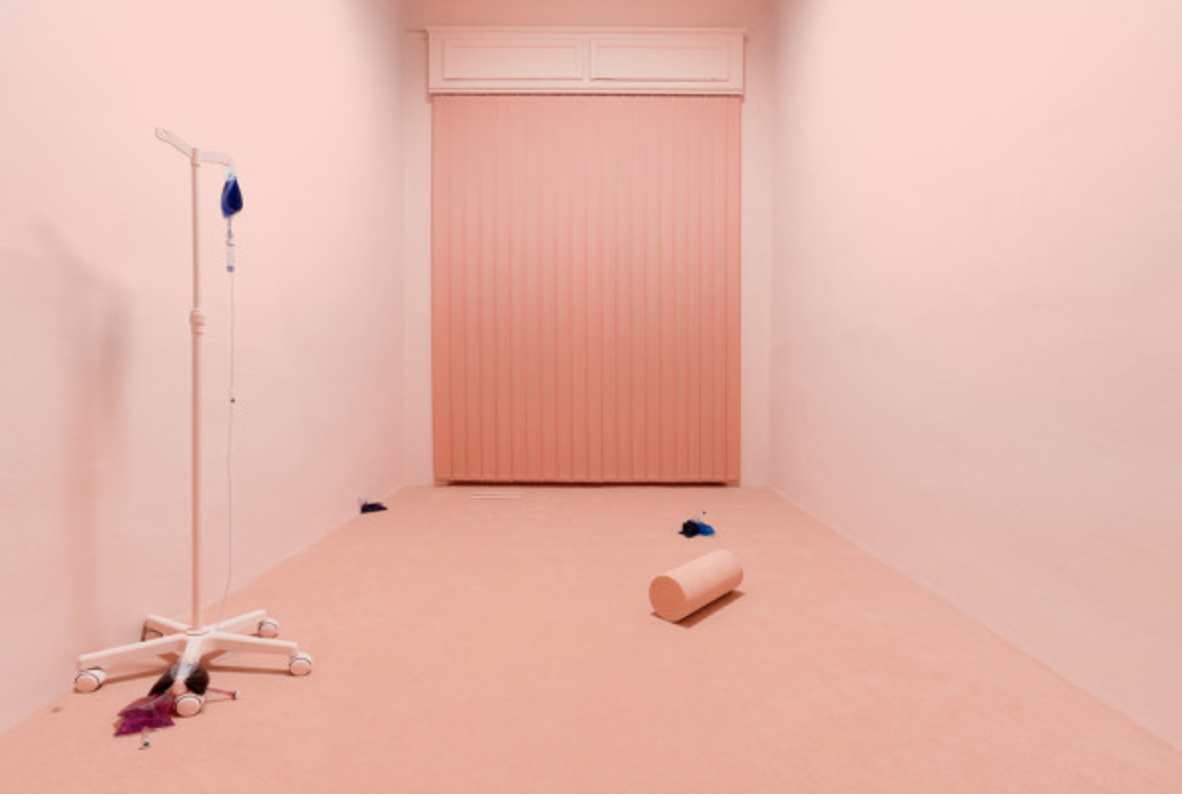Letizia Scarpello (Pescara, 1989, lives and works in Milan). She studied Costume and Scenography at the Brera Academy of Milan after a Bachelor’s degree in Fashion Design at the Istituto Marangoni in London. Analyzing the textile world in relation to human attitudes, for which the artist shows a strong interest filtered by a particular introspective sensitivity, Letizia indirectly puts much of herself into her work, though often in a veiled and not evident way. We can read this sensitivity in her research topic on which she is working, in particular starting from the latest works, the idea of relationship. Also influenced by dance and theater, other elements of her multifaceted professional path, Letizia’s interventions always want an interlocutor: it is never a mute object that is sufficient for itself, but rather an attempt, for the artist necessary to the work, of dialogue with its recipient. Speaking of interventions in relation to Letizia is not a random choice; another characteristic feature of her works is their relationship, again, with spaces and contexts that host them, with which they establish a dialogue and on which they intervene, generally without ever dealing with an action of distortion but always with light and delicate actions. However, this tendency has also been made possible by exceptions in which the viewer has been deprived of the complete freedom granted to him in previous works, and whose use of the work has been more directed towards a specific perspective.
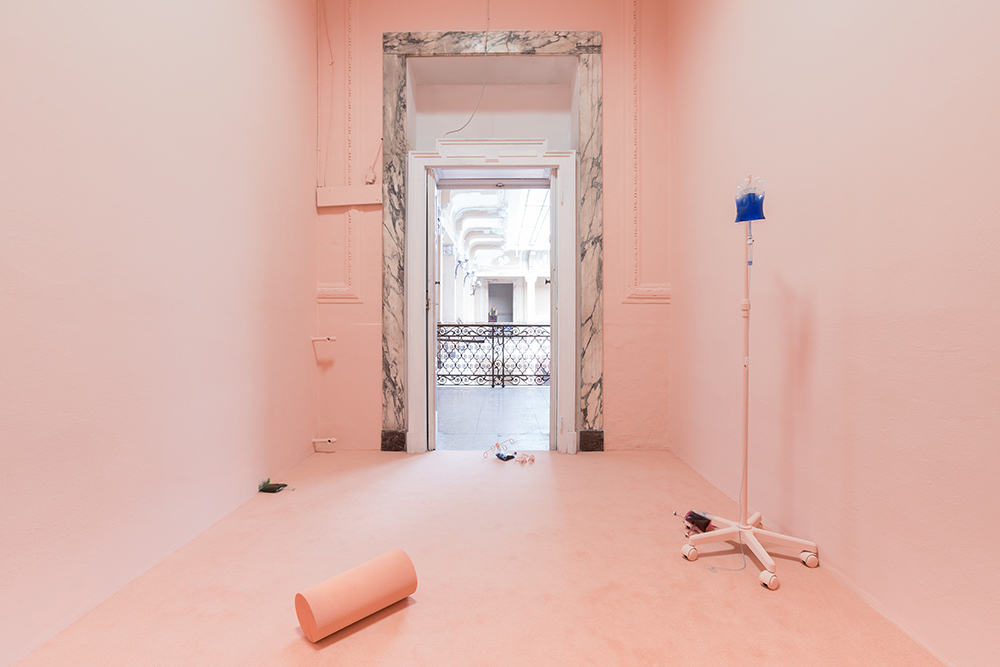
Federica Torgano: Your education is truly multifaceted, starting from dance, reaching theater and fashion. I liked your statement in which you said: “My brain is already divided between too many roles”. How did you get to art? Was it a step further, or is it something that has always been there?
Letizia Scarpello: Assuming that to me art is above all an attitude to life, yes, I think that it has always been there. As a child, I preferred to imitate my mother painting for hours rather than playing with the other kids and I think this was already a symptom. Alternatively, I was used to dancing, recording videos of Michael Jackson on VHS and studying them for hours, I still remember the choreography of Thriller. I have always spent all the time I can in feeling, people, things, the various forms of expression that surround me: building my point of view in dialogue with all these elements.
F.T. In which way was your residence of Viafarini, in 2016 and 2017, a fundamental experience for your career? Why do things have to be so hard? is the result of your second time in residence, can you tell us about the genesis of this work and how it is related to you?
L.S. The residence in Viafarini helped me get serious. What I mean is that when you are selected by an association as historically recognized as Viafarini to work a few months in a studio where you will be effectively studied, then you really understand that what you do can be important for others, as well as for yourself. At first, I did not think about it that much and I believe this depends also on the history of my professional training.
Why do things have to be so hard? talks about this too. It is a work on intention in art as an impulse mediated by responsibility and awareness. The title comes from an article read in the Internazionale which quotes the words of a girl written to her mother before committing suicide as example of the thousands of people who every day in Japan take their lives own lives due to excessive working rhythms. Sometimes you are so determined to reach a goal that you end up paradoxically losing its value. My graphic interventions in the space of Via Farini 35 tell of this loss in the current world, and not just in the artistic one. In fact, not by chance, the work has become the cover of my sister Serena’s book, who in Communicating Less, Communicating Better has expanded the reasoning also to the corporate world.
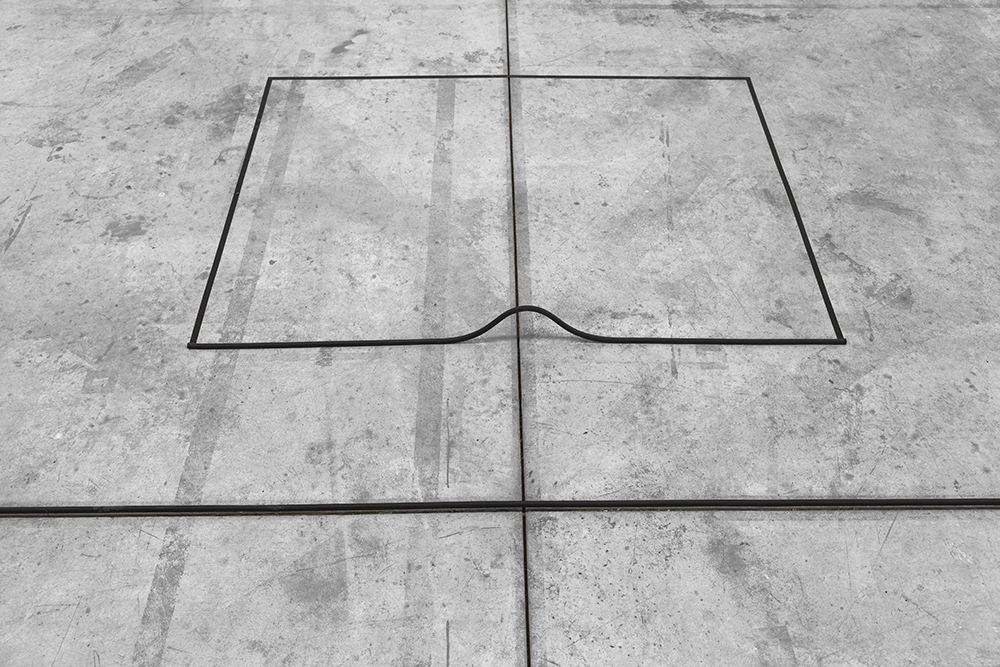
F.T. Taking a step back, your interest in philosophy intrigued me, which pours into your work in a more or less evident way, for example in Tra dei di luce e idoli di fango, which is the first work produced during your first experience in Viafarini. Could you tell us about this concern in relation to your work and tell us about this last project?
L.S. I believe that philosophy tries to reach the sense of satiety that only artistic production can satisfy. It goes beyond reason but cannot entirely get rid of it. It comes just before the moment you create or just after. And for this reason, I like studying philosophy and it helps to keep the right dose of concentration on analysis.
Tra dei di luce e idoli di fango is the reorganization, in the form of a story, of a series of color studies that I made in the first months of experimentation in Viafarini. I was not ready to show my samples on fabric and my abstract sketches on paper so basically, I organized a pretext: rolls of cotton that fell into the studio on the work of others and mine. In the opinion of many, those champions seemed to be images of heaven, therefore, following their imagination, I set them up as if they had fallen from above, curling up on themselves. I was reading The Myth of Sisyphus by Albert Camus, an intellectual, philosopher and French director well-known for his theories about the absurd from which I took inspiration for the genesis as well as for the title of the work.
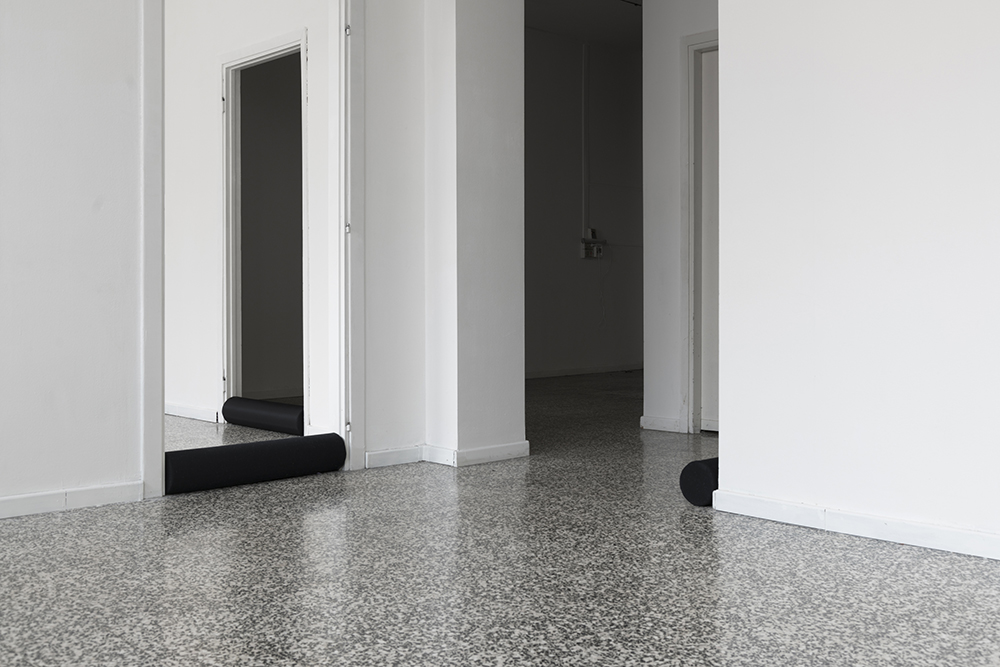
F.T. In The Beauties, your solo exhibition hosted by t-Space, the objects that make up the exhibition are also used as tools that generate durability. How does time and duration come into play?
L.S. The Beauties comes from my reflection on the idea of involvement in a work of art, that is to understand who and how, together with the artist, determines the value of a work. For me, the public plays a fundamental role in the life of a work, so I made it a fundamental part of the exhibition’s time and the master of its duration, thinking of it in a bilateral way. As a set of images or movement of objects, passive or active that was, The Beauties has thus transformed into a flow that saw the public, the true protagonist of the exhibition.
F.T. Furthermore, your artistic research reflects a lot on the role of the spectator in relation to the artistic object as a concrete object. The spectator instead of the passive recipient is intended as an active component. In which way exactly? What is the relationship / reaction you are looking for in your interventions?
L.S. The relationship is the spring that drives my entire work. I believe that life can be summarized in a “box” of relationships. The world can be defined as such only thanks to the activation of relationships between things and that the chains that are built are the history of existence. Therefore, the relationship between one of my works and its spectator is part of the success of that work. I never consider my work finished without an audience, and not because it needs the judgment of others, but because it is impossible not to recognize in art its being intrinsically and inevitably a form of representation. So, if there is not someone to show it to, what and for what are we representing? It is even more important that there is the public than the work itself, as the history of art taught us. So, as I think that the observer is part of my work, I like that the observer can feel the importance of its value, from time to time in different forms.
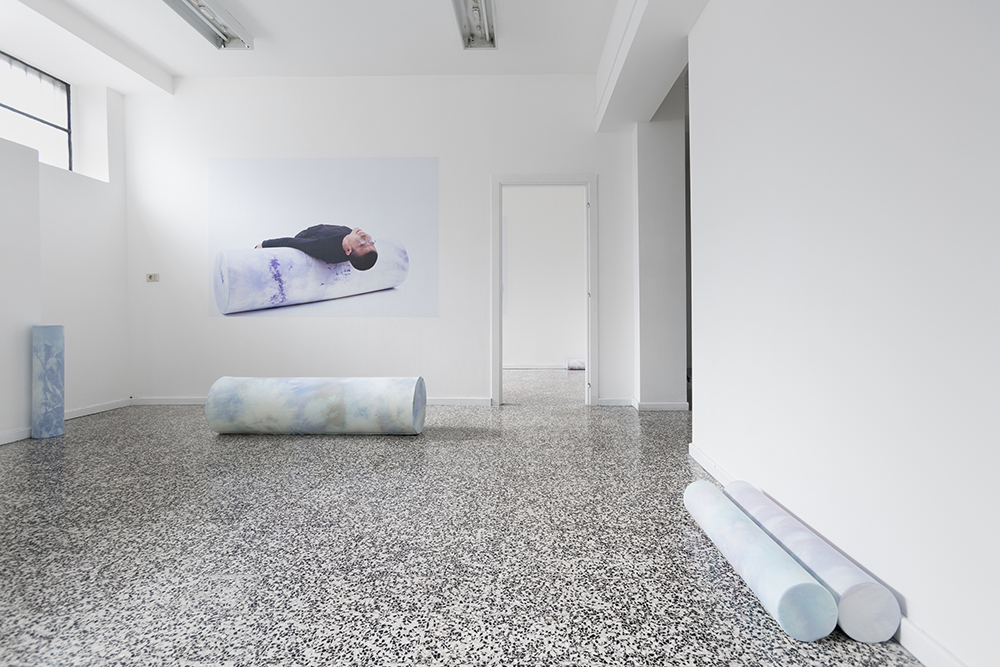
F.T. Both in The Beauties and in Troppo Umano (Too Human), realized at Macao – center for arts and culture in Milan, the space itself seems to play an important role, can you talk about it?
L.S. For me the space is the basis. Whether it is a sheet of paper or a room it doesn’t make a big difference. And the idea evolves from that base. In The Beauties it is evident how much I wanted to respect the coordinates of the space. In the positioning of the works I took into account the characteristics of the studio by measuring some details with which to make the objects dialogue, for example the width of doors or the length of some areas of the room’s perimeter. Whereas in Troppo Umano, for the first time I decided to transfigure the room. Not being able to leave out the context of Macao, which is the former Milan Slaughterhouse, I worked on the relationship between an interior and its exterior, opting to distort the one to highlight its relationship of contrast with the other.
F.T. Two other recurrent elements in your works seem to be the use of fabric, and its derivatives, and a certain attention to color. What does this use imply for you?
L.S. Leaving aside the intrinsic value of the fabric in relation to the history of man, I have always practiced it because I grew up in the attic of my family’s upholstery shop, located for more than sixty years in a nineteenth-century building in the center of Pescara. Samples upon samples, rolls and rolls of cotton, leathers, rubbers and yarns of all kinds that I started to study in a very intuitive way since I was a baby and I brought that with me in my art. Fabric is an instrument like others, which thanks to the color reaches its most complete expression in my work. Also, the depth of my imprint depends on the color, which I use mainly following dyeing techniques that implies immersion of materials.

photo by t-space studio email: info@t-space.it via bolama 2, Milano, MI Italia 
photo by t-space studio email: info@t-space.it via bolama 2, Milano, MI Italia
F.T. All these elements are also found in your latest project Troppo Umano, can you tell us about it?
L.S. Troppo Umano was born a couple of months ago starting from the proposal to think of a project for one of the rooms in Macao, the former slaughterhouse in Milan, which has recently been used as exhibition space and included in its socio-cultural program. I usually work adapting my intuitions to the context, in this occasion I wanted to push myself further and so I decided to distort the place. I imagined an exaggerating environment, a hyperbaric chamber, an aseptic meat-colored room. I placed a dozen drip-feeds at different heights that losing colored water on the carpet floor (the filling of the drip was made of pigments that I usually use to dye my work in fabric) have created a set of expanding spots, an abstract pictorial floor. I adjusted the flow of color thanks to the wheels placed at the beginning of the outflow tubing of the infusion, then filled according to my will. So, who actually was able to enter the room was only me, the viewer was allowed to peek from the entrance. The installation remained in motion along the entire duration of the exhibition.
Troppo Umano is a metaphor on the practice of art as a lifeblood. For this reason, I thought about working on objects that the human mind instantly associates with the concepts of care and recovery: the expressive medium, in this case the color, is the tool that in the realization of a work allows the artist as well as his interlocutor to reach a state of spiritual “healing”. Troppo Umano can therefore be imagined as a first-aid room to the loss of inspiration, as the representation of the intimate manifestation of a work. The title comes from having a coffee in Paolo Sarpi with the curator Ginevra Bria, who before writing the critical text to the show asked me: “Do you want to call him Human (Umano)? Human is little, this work is more than human, it is too human”. The reference to Human, All Too Human by Friedrich Nietzsche, is unmistakable.

F.T. Which readings have particularly influenced your work and what are you currently reading?
L.S. One of the texts that has influenced my practice the most is The Theater and its Double by Antonin Artaud and in general his vision of the reality that he described in other texts such as In the Country of Tarahumara or Succubi e supplizi. Artaud strongly believed in the psychophysical overcoming of oneself as the only possible way in art and life and as a visceral poet he changed my way of looking at things.
I am currently reading Bahagavadgita, a sacred text dear to Hindus and linked to the discipline of yoga that I have been practicing for years. And I just started Infrasottile by Elio Grazioli, whose point of view particularly interests me.
F.T. Do you already have any new projects in your future?
L.S. From this September I will participate in the program of artistic residencies HIGHLIGHTS organized by the association The Blank Contemporary Art in Bergamo. I will be a guest in their studio for a month, working hopefully without distractions, without being divided between too many roles.



